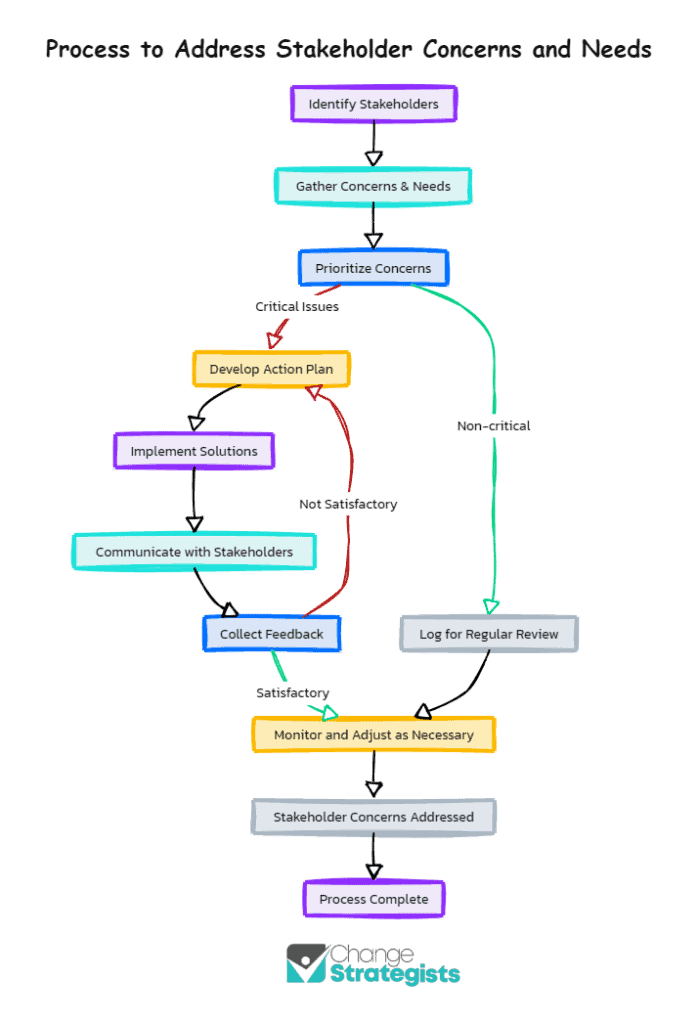When embarking on a change initiative, engaging stakeholders is crucial for success. Whether it’s a minor process improvement or a major organizational transformation, getting buy-in from those who will be affected by the change can make all the difference in achieving the desired outcomes.
In fact, studies have shown that projects with high levels of stakeholder engagement are more likely to be successful than those with low levels of engagement. So, what is the role of engaging stakeholders in change management, and how can you ensure that you are effectively involving them in your initiatives?
The answer lies in understanding the importance of stakeholder involvement and implementing strategies to engage them throughout the change process. By doing so, you can address their concerns and needs, maximize their participation and buy-in, and leverage their expertise for successful change implementation.
In this article, we will explore these concepts in depth and provide practical tips for engaging stakeholders in your change initiatives. Whether you are a change manager, project manager, or team leader, this information will be valuable in helping you achieve your goals and drive positive change within your organization.
The Importance of Stakeholder Involvement in Change Management
It’s crucial to involve those affected by the transition in order to successfully implement new procedures. Engaging stakeholders in change management has become an essential step for organizations to ensure a smooth and successful transition.
When stakeholders are involved in the process, they feel valued and respected, which can have a positive impact on their willingness to cooperate and support the change.
One of the main benefits of stakeholder engagement is that it helps to identify potential issues and concerns before they become major problems. By soliciting feedback from those impacted by the change, organizations can gain valuable insights into their needs, expectations, and fears.
This information can be used to develop a more effective change management plan that addresses these concerns and minimizes resistance.
On the other hand, ignoring stakeholder input can lead to significant risks and challenges. When stakeholders feel excluded from the process, they may become resistant to the change or even hostile towards it.
This can lead to delays, decreased morale, and increased costs. Additionally, stakeholders may have valuable insights and expertise that can be leveraged to improve the change process. By ignoring their input, organizations miss out on these opportunities to improve and innovate.
Involving stakeholders in change management is not only crucial for a successful transition but also essential for building trust and fostering a positive organizational culture. By demonstrating a commitment to collaboration and open communication, organizations can create a culture that values and respects the input of all stakeholders.
This can lead to increased engagement, productivity, and innovation, which can have a significant impact on the organization’s long-term success.
Strategies for Engaging Stakeholders in Change Initiatives
As you navigate the process of implementing new initiatives, it’s important to consider the various perspectives and input of those who will be affected by the changes, in order to ensure a smooth and successful transition.

Effective communication with stakeholders can help to build trust and create a sense of shared ownership over the change process, ultimately leading to greater buy-in and commitment from those involved.
One strategy for engaging stakeholders is to involve them in the planning and decision-making process from the outset.
This can be done through focus groups, surveys, or other methods of soliciting feedback and input.
By involving stakeholders in the planning phase, you can gain valuable insights into their needs and concerns, and incorporate their perspectives into the design of the initiative.
Another important strategy is to provide regular updates and progress reports to stakeholders throughout the implementation process.
This can help to build trust and transparency, and ensure that everyone is on the same page regarding the status of the initiative.
It also provides an opportunity for stakeholders to provide feedback and make adjustments as needed, which can help to prevent potential roadblocks or resistance to the change down the line.
- Foster open and honest communication channels between stakeholders.
- Encourage stakeholder involvement in the planning and decision-making process.
- Provide regular updates and progress reports to stakeholders throughout implementation.
By following these strategies, you can effectively engage stakeholders in the change process and ensure a smooth and successful transition. Building trust and effective communication are key components of any change initiative, and taking the time to involve stakeholders can ultimately lead to greater buy-in and commitment from those involved.
Addressing Stakeholder Concerns and Needs
In this section, we’ll explore how to address the concerns and needs of those impacted by the changes, ensuring a smoother transition and greater support for the initiative.
When stakeholders are involved in the change management process, their concerns and needs must be addressed to guarantee their buy-in and smooth transition.

To do this, you need to identify all the stakeholders impacted by the change and understand their needs and concerns. This will enable you to tailor your communication and engagement strategies to address their specific needs and concerns.
One way to address stakeholders’ concerns and needs is to communicate openly and transparently. You need to provide clear and concise information about the change initiative and the reasons behind it. You also need to be honest about any potential drawbacks or challenges that may arise. This will help build trust and improve buy-in from stakeholders.
Additionally, you need to provide opportunities for stakeholders to ask questions and provide feedback. This will help you identify any concerns or issues that need to be addressed promptly.
Finally, you need to provide support to stakeholders throughout the change initiative. This could mean providing training or resources to help them adapt to the changes, or it could mean providing emotional support to help them cope with any challenges or stressors that may arise. You also need to ensure that stakeholders are involved in the ongoing evaluation of the change initiative, allowing them to provide feedback and make adjustments as needed.
By addressing stakeholders’ concerns and needs, you can ensure a smoother transition and greater support for the change initiative.
Maximizing Stakeholder Participation and Buy-In
Maximizing stakeholder participation and buy-in is crucial for successfully implementing organizational changes. Collaborative decision making is an effective approach that involves stakeholders in the decision-making process. This approach ensures that stakeholders are not only aware of the changes but also have a say in the implementation process.
Collaborative decision making can be achieved through regular meetings, feedback sessions, and surveys. These sessions should be structured in a way that allows stakeholders to express their opinions and concerns freely.
Communication techniques are also essential in maximizing stakeholder participation and buy-in. Clear and concise communication is critical in ensuring that stakeholders understand the changes and the reasons behind them.
Communication should be tailored to the specific needs and concerns of each stakeholder group. It’s also important to provide regular updates to stakeholders on the progress of the change process. This helps to build trust and confidence in the change process.
Maximizing stakeholder participation and buy-in is not only important for the success of change management, but it also creates a sense of ownership among stakeholders.
Collaborative decision making and effective communication techniques help to ensure that stakeholders feel like they are part of the process. This approach not only increases the likelihood of successful implementation but also helps to create a culture of continuous improvement.
By involving stakeholders in the change process, organizations can leverage their expertise and experience to achieve the desired outcomes.
Leveraging Stakeholder Expertise for Successful Change Implementation
You can tap into the knowledge and experience of your stakeholders to ensure a smooth and successful implementation of organizational changes, ultimately leading to a more efficient and effective workplace.
Leveraging stakeholder expertise is an essential aspect of change management, as it enables you to identify potential challenges, develop effective strategies, and gain buy-in from those most affected by the changes.
Stakeholder communication is a critical component of leveraging stakeholder expertise. By engaging with stakeholders early in the change process, you can identify potential resistance and develop strategies to mitigate it. Effective communication also helps build trust and credibility, which can increase stakeholder buy-in and support.
Conducting a change readiness assessment is another essential component of leveraging stakeholder expertise.
This assessment helps you identify potential roadblocks, such as resistance to change or lack of resources, and develop strategies to address them.
By involving stakeholders in this process, you can gain valuable insights and ensure that your change management plan is aligned with the needs and expectations of those most affected by the changes.
How Can Engaging Stakeholders in Change Management Help Address Resistance to Change?
Engaging stakeholders in change management is crucial for addressing the psychology of change resistance understanding. By involving key individuals in the decision-making process and communicating openly, organizations can gain valuable insights and perspectives. This collaborative approach can help identify and address concerns, ultimately leading to a smoother transition.
Final Thoughts
Think about a time when you were part of a change initiative that failed, leaving you feeling frustrated and disengaged.
Now, picture a time when you were actively involved in a change process, contributing your insights and expertise, and seeing the positive impact of your efforts. The difference? Stakeholder involvement.
By engaging stakeholders in change initiatives, organizations can tap into a wealth of knowledge, skills, and perspectives that can drive successful outcomes.
From the early stages of planning to the final stages of implementation, stakeholder engagement is a critical factor in achieving buy-in, addressing concerns and needs, and maximizing participation.
By leveraging stakeholder expertise and involving them in decision-making, organizations can create a collaborative and inclusive culture that supports change and drives results.
In conclusion, stakeholder engagement is not a nice-to-have, but a must-have for successful change management.
By prioritizing stakeholder involvement and addressing their concerns and needs, organizations can create a more positive and productive change process.
So, as you embark on your next change initiative, remember the importance of engaging stakeholders and the impact it can have on your success.





